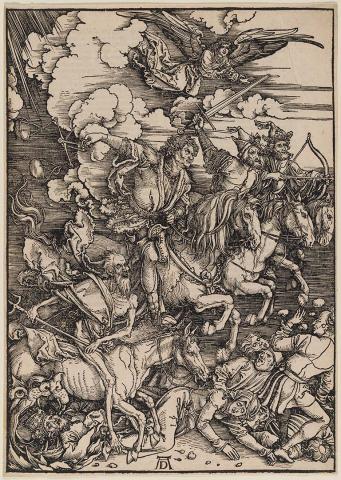LABEL: 2013.135 DÜRER
By Geraldine Kirrihi Barlow Ineke Dane
February 2024
Albrecht Dürer was 27 years old when he published ‘The Revelations of St John the Divine’, better known as ‘The Apocalypse’ series. With its predictions of catastrophe, chaos and turmoil, it captured the imagination of populations — educated and illiterate alike — throughout Europe as the end of the fifteenth century approached.
Dürer’s dramatic, graphic interpretation revolutionised the way in which text and image were published and disseminated. His level of skill transformed the practice of woodblock printing from its secondary, illustrative status to an independent art form. The vivid full-page compositions articulate an almost hallucinatory vision of ‘the end of days’.
The most iconic image to emerge from Dürer’s series is the third woodcut, The Four Horsemen of The Apocalypse. The image presents a dramatic illustration of a passage from the Book of Revelation, wherein the writer describes a vision of four horses. From top right: the rider of the ‘plague’ horse holds a bow; war’s rider holds a sword; famine’s rider holds a set of scales; and, at bottom left, we see the figure of Death astride a sickly horse with visible ribs. Riding abreast, the horsemen trample those in their path: a cardinal is the first to be swallowed up by the jaws of Hell, signifying that even the powerful could not hide from God’s Judgement.
Connected objects
Metadata, copyright and sharing information
About this story
- Subject
